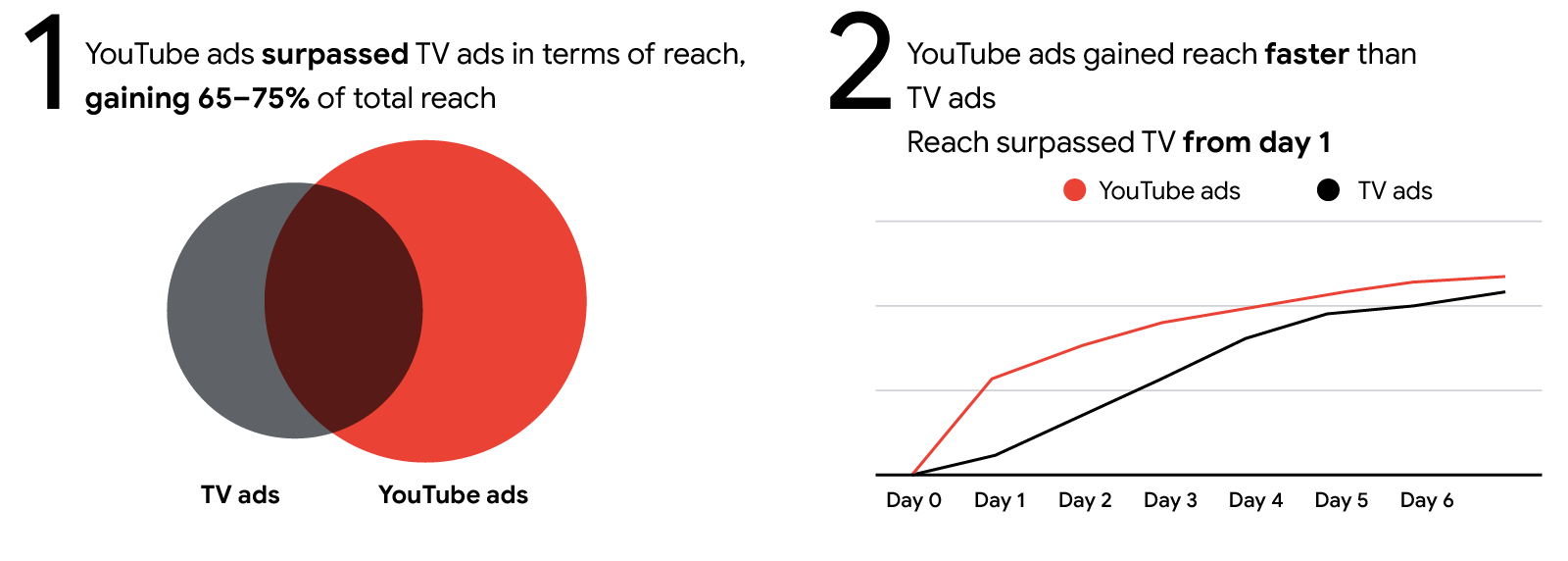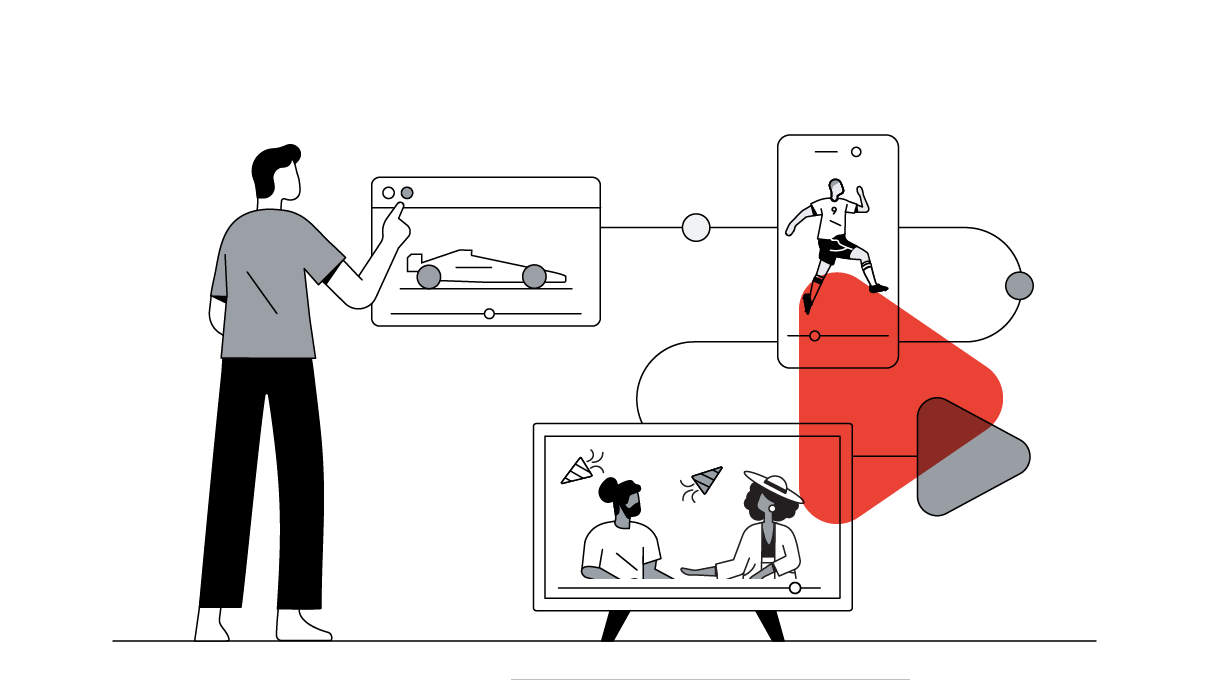Following the insights from how to optimize ad spend to reach audiences that matter by developing cross-media ad strategies and effectively measuring the value of reach, Natsuko Ikeda, APAC Media Strategist in Google Media Lab, shares takeaways from the TV vs. YouTube comparison campaign ran by Google Japan.
Videos are going digital faster than high-speed bullet trains can carry you across Japan. The number of people logging in to YouTube every month has passed 2 billion worldwide.1 Over 1 billion hours of video are watched every day, with billions of video views. As of June 2020, over 240 channels in Japan had over a million subscribers,2 and the hours of video uploaded on Japanese channels was 80% higher than the same time last year.3
People are also using different devices to access YouTube now. While smartphones, tablets, and PCs previously made up the majority, TV screens have been increasing in recent years. In Japan particularly, video viewing has increased on TV more than any other device, with a 110% rise in 2020 compared to the previous year.4
Unlike smartphones, tablets, and PCs, the increase in TV viewing suggests that people are watching YouTube videos with their families, partners, or children. And as more people join YouTube and move from smartphones and PCs to watching on their TVs, brands can take advantage of new ways to deliver messages to their audiences.
The question: Do digital campaigns have the same reach as offline media?
In Japan, there is a perception that nothing can surpass TV in terms of advertising reach, which makes sense when advertisers can get almost 100% nationwide coverage between five TV networks as of 2018.5 This leads many companies to spend the majority of their brand budget on TV and then allocate the remainder to digital.
Creative production follows the budget. Storyboards are initially created with a 30-second TV commercial in mind and then cut down and adapted for digital video ads.
However, as people trend toward digital media in Japan, brands should ask themselves if they are adapting the way they execute their media and creative to reach digital audiences. If not, they may be missing the opportunity to reach a broader audience by taking a digital-first marketing approach.
The experiment: Compare Google’s brand ads on TV and YouTube
In an effort to truly understand the scale of digital media in Japan, Google Marketing used Google’s own campaigns during the second half of 2019 to compare the target reach of TV and YouTube.
Our research team designed campaigns that ran ads across TV and YouTube at comparable terms of duration, geographical coverage, target audience, volume, and budget.
These experiments ran for two weeks at a time. During the first week, TV commercials ran, and during the second week, YouTube ads ran with similar Target Rating Points (TRP), which is the percentage of the target audience reached by a campaign. Then, the research team compared the results from week 1 and week 2.
The same test was carried out four times, all within Google’s standard advertising campaign across the Kanto, Kansai, and Chukyo regions of Japan. All YouTube ads were bought through reservation and auction and were non-skippable to compare with TV’s non-skip ability. Each experiment varied slightly, as shown in the chart below:

For this test, Google used the “TV × YouTube Cross-Media Reach Report” from the research firm Intage to measure TV and YouTube reach. By combining Intage’s TV-commercial exposure data with Google’s data, we could get an in-depth understanding and see the duplication of TV and YouTube cross-media reach.
The results: YouTube Ads reached more people, including those who don’t watch TV
Overall, TV and YouTube ads achieved a combined reach of 66% to 78% against our target audience. Of that figure, YouTube’s individual contribution to the reach ranged between 65% and 75%, equal to or higher (by 1.1-1.4X) than TV’s individual reach contribution.
The reach from digital advertising is often expressed as an incremental reach to that of television. But for this test, with TV’s unique contribution being only 25% to 35%, it’s more accurate to say that TV was actually incremental to digital.

Additionally, for all tests, YouTube accumulated reach faster than TV from day one. This resulted in YouTube building reach quickly during the test week.
The secret sauce: 6-second bumper ads, reservations, and frequency caps
While YouTube outperformed TV in reaching a wide age range of 18-49 across all three regions (Kanto, Kansai, Chukyo), different ad durations can help optimize reach.
We found that while a 15-second ad was sufficient in driving reach among the younger age group (18-34) in Kanto, a combination of 15-second and 6-second ad formats were extremely effective in reaching a broader audience. And 6-second “bumper ads” can access a wider variety of inventory on YouTube, so brands should use them in conjunction with 15-second formats to achieve an even greater reach.
Another helpful tool was reservation-based ads, typically used to secure placements with high visibility or on popular channels. Reserving inventory on a fixed CPM (cost-per-thousand impressions) for select time periods helped us guarantee inventory during this short test period. These ads provided a broad reach on YouTube, even during the short one-week experiment.
Lastly, YouTube’s frequency cap helped limit the number of times ads were displayed per viewer. Instead of spending budget on the same person, we were able to deliver ads to more unique people during the test period, generating larger reach.
These three key factors played a big role in maximizing reach on YouTube within a short period. And they have since been deployed for other similar campaigns in APAC, showing these tools can help across other markets as well.
The takeaway: Consider how media consumption is evolving when allocation budget
While limited by location and age group, this test showed YouTube’s potential to reach a greater number of people than TV in a shorter time span. YouTube’s ability to reach people from the first day and to reach people who don’t watch TV showed us how indispensable YouTube is in the overall media mix.
Planning tools based on historical data sets may be capable of precise simulations but are often difficult in producing outputs that reflect the real-time media dynamics of today.
Sure, historical data can help build simulations, but if that simulation doesn’t accurately predict campaign performance today, it’s not helping brands use their budgets wisely. When considering media mix, it’s important to understand the most recent data and make budget allocations that fit the current market.
Google plans to conduct more tests across regions to measure the impact of TV and YouTube against both brand and business objectives. Our goal is to identify the optimal media mix for video ads for our Google Marketing team and bring those learnings to the whole advertising industry.







